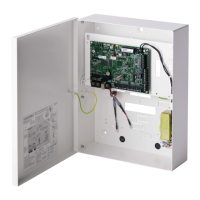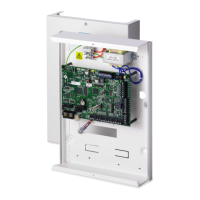Do you have a question about the Vanderbilt SPC5330.320 and is the answer not in the manual?
Covers essential safety warnings, handling precautions, and general installation guidelines.
Provides an overview of the SPC's compliance with the EN50131 standard.
Lists relevant standards for PD 6662:2010 conformance implementation.
Details methods for completing system setting and unsetting procedures as per BS 8243:2010.
Includes information for system design proposals and as-fitted documents, emphasizing dual paths and confirmation facilities.
Details hardware requirements for VdS compliance, including housing and keypad specifications.
Lists technical specifications for the SPC4000 model, including programmable areas, PINs, and hardware features.
Lists technical specifications for the SPC5000 model, including programmable areas, PINs, and hardware features.
Lists technical specifications for the SPC6000 model, including programmable areas, PINs, and hardware features.
Lists technical specifications for the SPCP355.300, including zones, outputs, and interfaces.
Details the process for mounting the SPC G2 housing, including screw holes and recommended fixings.
Describes how to mount the SPC G3 housing, including cover attachment and PCB mounting.
Explains how to mount a back tamper kit for enhanced security and its components.
Details battery retention methods for EN50131 compliance and correct battery biasing.
Describes the mounting of the SPC G5 housing, including component layout and expander installation.
Explains tamper protection mechanisms for the housing, using switches for front and back tamper.
Provides steps for mounting the housing with tamper protection, including drill positions and bracket adjustment.
Provides instructions for installing batteries, including careful handling and using matching capacities.
Refers to corresponding installation instructions for mounting keypads.
Refers to corresponding installation instructions for mounting expanders.
Details the SPCP355.300 Smart PSU, including its power supply, expander functionality, and X-BUS interface.
Explains the three supervised, open-drain logical outputs and their tamper detection configuration.
Covers battery installation, voltage testing, deep discharge protection, and stand-by times.
Provides a visual guide and steps for installing batteries in the SPCP355.300 Smart PSU and G5 Housing.
Explains how to wire the expander's 8 on-board zone inputs, including End of Line configurations.
Describes how expander and PSU relay logical outputs can be assigned to SPC system outputs.
Outlines requirements for NF and A2P approvals, including housing sealing and disabling the HTTP web server.
Details the controller hardware for SPC42xx, 43xx, 53xx, and 63xx models, including optional wireless modules.
Describes the SPC5350 and SPC6350 controller hardware, including default expander ID settings.
Details the X-BUS interface connections for expanders and keypads, including wiring configurations and cable types.
Explains loop configuration for X-BUS wiring, noting it's not supported by SPC42xx/43xx and the importance of termination jumpers.
Describes spur (open loop) cabling for X-BUS, offering fault tolerance and convenience, and the numbering scheme for expanders.
Explains star and multi-drop cabling methods, their limitations, and suitability for specific environments.
Describes the wiring of the X-BUS interface for connecting additional branch expanders and lists modules with this capability.
Explains how to wire the on-board relay output for driving external bells or strobes and its activation upon relay activation.
Details how to wire the SPC controller's 8 on-board zone inputs, supporting various End of Line supervision configurations.
Describes wiring an external bell to the SPC controller board using the relay output and BHO/TR terminals.
Explains how to connect an internal sounder to the SPC controller's IN+ and IN- terminals.
Details the wiring of the glassbreak interface with GB2001 glassbreak detectors.
Provides instructions for installing modems (PSTN or GSM) on the controller board and warnings about hot-plugging.
Provides recommendations for powering the system from battery only, including charge state and deep discharge levels.
Explains how to use the keypad for quick onsite access to system menus and initial default configurations.
Guides through configuring initial system settings such as language, region, installation type, and security grade.
Describes how to create system users, assign roles, and manage PINs, with considerations for firmware upgrades.
Covers X-BUS addressing, refresh, reconfigure, and locating/monitoring expanders and keypads.
Details X-BUS addressing modes (Manual/Auto) and the formula for zone allocation based on expander ID.
Explains how to assign output types to physical ports and configure output behavior like mode, retrigger, and logging.
Covers configuring communication settings, including serial ports, Ethernet, modems, central stations, and SPC Connect PRO.
Explains how to install and configure GSM and PSTN modems for communication, including SMS features.
Guides on adding, editing, deleting, and testing central stations (ARCs) for alarm reporting.
Covers various system tests, including bell tests, walk tests, zone monitors, output tests, and soak tests.
Guides on performing manual and automatic seismic tests, including interpreting results and failed zones.
Details how the SPC system supports SMS alerts and remote control via SMS, including configuration requirements.
Explains how to control doors, allowing selection of door states like Normal, Momentary, Locked, and Unlocked.
Details how to set up SPC Connect ATS for remote panel access and registration via the SPC Connect website.
Guides on logging into the SPC browser application using an IP address, username, and PIN.
Introduces the SPC Home page, which includes System Summary, Alarms, and Video tabs for system monitoring.
Details how to view zone status, including zone description, area, type, EOL quality, input, and status.
Covers managing users, user profiles, PACE devices, SMS IDs, web passwords, RF fobs, and MDT devices.
Guides on adding or editing users, including entering user ID, name, PIN, and access control settings.
Covers adding and editing user profiles, defining their access rights, and assigning calendars.
Guides on configuring SMS for remote panel messaging, including prerequisites and SMS ID management.
Lists available SMS commands for controlling the SPC system, including setting/unsetting, engineer access, and output control.
Introduces wireless sensor detection, compatible modules, and devices for one-way and two-way transceivers.
Covers configuring controller inputs, outputs, X-BUS, system settings, zones, doors, areas, calendars, and PINs.
Guides on configuring controller inputs and outputs, including editing inputs and outputs, and setting up latch/auto set.
Covers configuring X-BUS connections, including expanders, keypads, door controllers, cable map, and settings.
Covers changing system settings like options, timers, identification, standards, clock, and language.
Details system options configuration, including areas, code restore, offline tamper, keyfob restore, and audio/video settings.
Details various timers for audible indications, alarm confirmation, dialer delay, setting authorization, and system parameters.
Explains how to configure standards compliance by selecting Continent, Installation Type, Region, and Grade.
Covers configuring zones, doors, and areas, including editing zones, adding areas, and door controller settings.
Guides on configuring cause and effect relationships between triggers, outputs, and actions.
Covers configuring communication settings, including networking services, Ethernet, modems, and serial ports.
Explains how to install and configure GSM and PSTN modems for communication, including SMS features.
Details how the SPC system supports SMS alerts and remote control via SMS, including configuration requirements.
Provides detailed steps for configuring GSM modems, including country code, PIN, answer mode, and technology selection.
Details how to configure PSTN modems, including country code, incoming calls, prefix, and line monitoring.
Explains the SPC Flexible Secure Communications Protocol (FlexC) for ATS communication.
Covers configuring reporting settings for Alarm Reporting Centres (ARCs), EDP setup, and CEI-ABI protocol.
Guides on adding, editing, deleting, and testing central stations (ARCs) for alarm reporting.
Covers PC tools for managing the SPC system, including SPC Connect PRO and SPC Manager.
Covers performing operations on panel files and configuration, including upgrading firmware, languages, and managing files.
Covers accessing the web server remotely via PSTN or GSM connections.
Covers intruder alarm operation modes: Financial, Commercial, and Domestic, and their supported alarm modes.
Details seismic sensors used for intrusion detection and their support in Financial mode installations.
Covers manual and automatic seismic sensor testing, including test processes and results storage.
Explains blocking lock operation and authorized setting, including requirements for normal and Bosch Blockschloss devices.
Provides a brief description of each zone type available on the SPC system, including ALARM, ENTRY/EXIT, FIRE, etc.
Explains how zone attributes determine the behavior of programmed zone types, including Access, Exclude, 24 Hour, and Local.
Covers essential safety warnings, handling precautions, and general installation guidelines.
Provides an overview of the SPC's compliance with the EN50131 standard.
Lists relevant standards for PD 6662:2010 conformance implementation.
Details methods for completing system setting and unsetting procedures as per BS 8243:2010.
Includes information for system design proposals and as-fitted documents, emphasizing dual paths and confirmation facilities.
Details hardware requirements for VdS compliance, including housing and keypad specifications.
Lists technical specifications for the SPC4000 model, including programmable areas, PINs, and hardware features.
Lists technical specifications for the SPC5000 model, including programmable areas, PINs, and hardware features.
Lists technical specifications for the SPC6000 model, including programmable areas, PINs, and hardware features.
Lists technical specifications for the SPCP355.300, including zones, outputs, and interfaces.
Details the process for mounting the SPC G2 housing, including screw holes and recommended fixings.
Describes how to mount the SPC G3 housing, including cover attachment and PCB mounting.
Explains how to mount a back tamper kit for enhanced security and its components.
Details battery retention methods for EN50131 compliance and correct battery biasing.
Describes the mounting of the SPC G5 housing, including component layout and expander installation.
Explains tamper protection mechanisms for the housing, using switches for front and back tamper.
Provides steps for mounting the housing with tamper protection, including drill positions and bracket adjustment.
Provides instructions for installing batteries, including careful handling and using matching capacities.
Refers to corresponding installation instructions for mounting keypads.
Refers to corresponding installation instructions for mounting expanders.
Details the SPCP355.300 Smart PSU, including its power supply, expander functionality, and X-BUS interface.
Explains the three supervised, open-drain logical outputs and their tamper detection configuration.
Covers battery installation, voltage testing, deep discharge protection, and stand-by times.
Provides a visual guide and steps for installing batteries in the SPCP355.300 Smart PSU and G5 Housing.
Explains how to wire the expander's 8 on-board zone inputs, including End of Line configurations.
Describes how expander and PSU relay logical outputs can be assigned to SPC system outputs.
Outlines requirements for NF and A2P approvals, including housing sealing and disabling the HTTP web server.
Details the controller hardware for SPC42xx, 43xx, 53xx, and 63xx models, including optional wireless modules.
Describes the SPC5350 and SPC6350 controller hardware, including default expander ID settings.
Details the X-BUS interface connections for expanders and keypads, including wiring configurations and cable types.
Explains loop configuration for X-BUS wiring, noting it's not supported by SPC42xx/43xx and the importance of termination jumpers.
Describes spur (open loop) cabling for X-BUS, offering fault tolerance and convenience, and the numbering scheme for expanders.
Explains star and multi-drop cabling methods, their limitations, and suitability for specific environments.
Describes the wiring of the X-BUS interface for connecting additional branch expanders and lists modules with this capability.
Explains how to wire the on-board relay output for driving external bells or strobes and its activation upon relay activation.
Details how to wire the SPC controller's 8 on-board zone inputs, supporting various End of Line supervision configurations.
Describes wiring an external bell to the SPC controller board using the relay output and BHO/TR terminals.
Explains how to connect an internal sounder to the SPC controller's IN+ and IN- terminals.
Details the wiring of the glassbreak interface with GB2001 glassbreak detectors.
Provides instructions for installing modems (PSTN or GSM) on the controller board and warnings about hot-plugging.
Provides recommendations for powering the system from battery only, including charge state and deep discharge levels.
Explains how to use the keypad for quick onsite access to system menus and initial default configurations.
Guides through configuring initial system settings such as language, region, installation type, and security grade.
Describes how to create system users, assign roles, and manage PINs, with considerations for firmware upgrades.
Covers X-BUS addressing, refresh, reconfigure, and locating/monitoring expanders and keypads.
Details X-BUS addressing modes (Manual/Auto) and the formula for zone allocation based on expander ID.
Explains how to assign output types to physical ports and configure output behavior like mode, retrigger, and logging.
Covers configuring communication settings, including serial ports, Ethernet, modems, central stations, and SPC Connect PRO.
Explains how to install and configure GSM and PSTN modems for communication, including SMS features.
Guides on adding, editing, deleting, and testing central stations (ARCs) for alarm reporting.
Covers various system tests, including bell tests, walk tests, zone monitors, output tests, and soak tests.
Guides on performing manual and automatic seismic tests, including interpreting results and failed zones.
Details how the SPC system supports SMS alerts and remote control via SMS, including configuration requirements.
Explains how to control doors, allowing selection of door states like Normal, Momentary, Locked, and Unlocked.
Details how to set up SPC Connect ATS for remote panel access and registration via the SPC Connect website.
Guides on logging into the SPC browser application using an IP address, username, and PIN.
Introduces the SPC Home page, which includes System Summary, Alarms, and Video tabs for system monitoring.
Details how to view zone status, including zone description, area, type, EOL quality, input, and status.
Covers managing users, user profiles, PACE devices, SMS IDs, web passwords, RF fobs, and MDT devices.
Guides on adding or editing users, including entering user ID, name, PIN, and access control settings.
Covers adding and editing user profiles, defining their access rights, and assigning calendars.
Guides on configuring SMS for remote panel messaging, including prerequisites and SMS ID management.
Lists available SMS commands for controlling the SPC system, including setting/unsetting, engineer access, and output control.
Introduces wireless sensor detection, compatible modules, and devices for one-way and two-way transceivers.
Covers configuring controller inputs, outputs, X-BUS, system settings, zones, doors, areas, calendars, and PINs.
Guides on configuring controller inputs and outputs, including editing inputs and outputs, and setting up latch/auto set.
Covers configuring X-BUS connections, including expanders, keypads, door controllers, cable map, and settings.
Covers changing system settings like options, timers, identification, standards, clock, and language.
Details system options configuration, including areas, code restore, offline tamper, keyfob restore, and audio/video settings.
Details various timers for audible indications, alarm confirmation, dialer delay, setting authorization, and system parameters.
Explains how to configure standards compliance by selecting Continent, Installation Type, Region, and Grade.
Covers configuring zones, doors, and areas, including editing zones, adding areas, and door controller settings.
Guides on configuring cause and effect relationships between triggers, outputs, and actions.
Covers configuring communication settings, including networking services, Ethernet, modems, and serial ports.
Explains how to install and configure GSM and PSTN modems for communication, including SMS features.
Details how the SPC system supports SMS alerts and remote control via SMS, including configuration requirements.
Provides detailed steps for configuring GSM modems, including country code, PIN, answer mode, and technology selection.
Details how to configure PSTN modems, including country code, incoming calls, prefix, and line monitoring.
Explains the SPC Flexible Secure Communications Protocol (FlexC) for ATS communication.
Covers configuring reporting settings for Alarm Reporting Centres (ARCs), EDP setup, and CEI-ABI protocol.
Guides on adding, editing, deleting, and testing central stations (ARCs) for alarm reporting.
Covers PC tools for managing the SPC system, including SPC Connect PRO and SPC Manager.
Covers performing operations on panel files and configuration, including upgrading firmware, languages, and managing files.
Covers accessing the web server remotely via PSTN or GSM connections.
Covers intruder alarm operation modes: Financial, Commercial, and Domestic, and their supported alarm modes.
Details seismic sensors used for intrusion detection and their support in Financial mode installations.
Covers manual and automatic seismic sensor testing, including test processes and results storage.
Explains blocking lock operation and authorized setting, including requirements for normal and Bosch Blockschloss devices.
Provides a brief description of each zone type available on the SPC system, including ALARM, ENTRY/EXIT, FIRE, etc.
Explains how zone attributes determine the behavior of programmed zone types, including Access, Exclude, 24 Hour, and Local.
| Brand | Vanderbilt |
|---|---|
| Model | SPC5330.320 |
| Category | Power Supply |
| Language | English |









